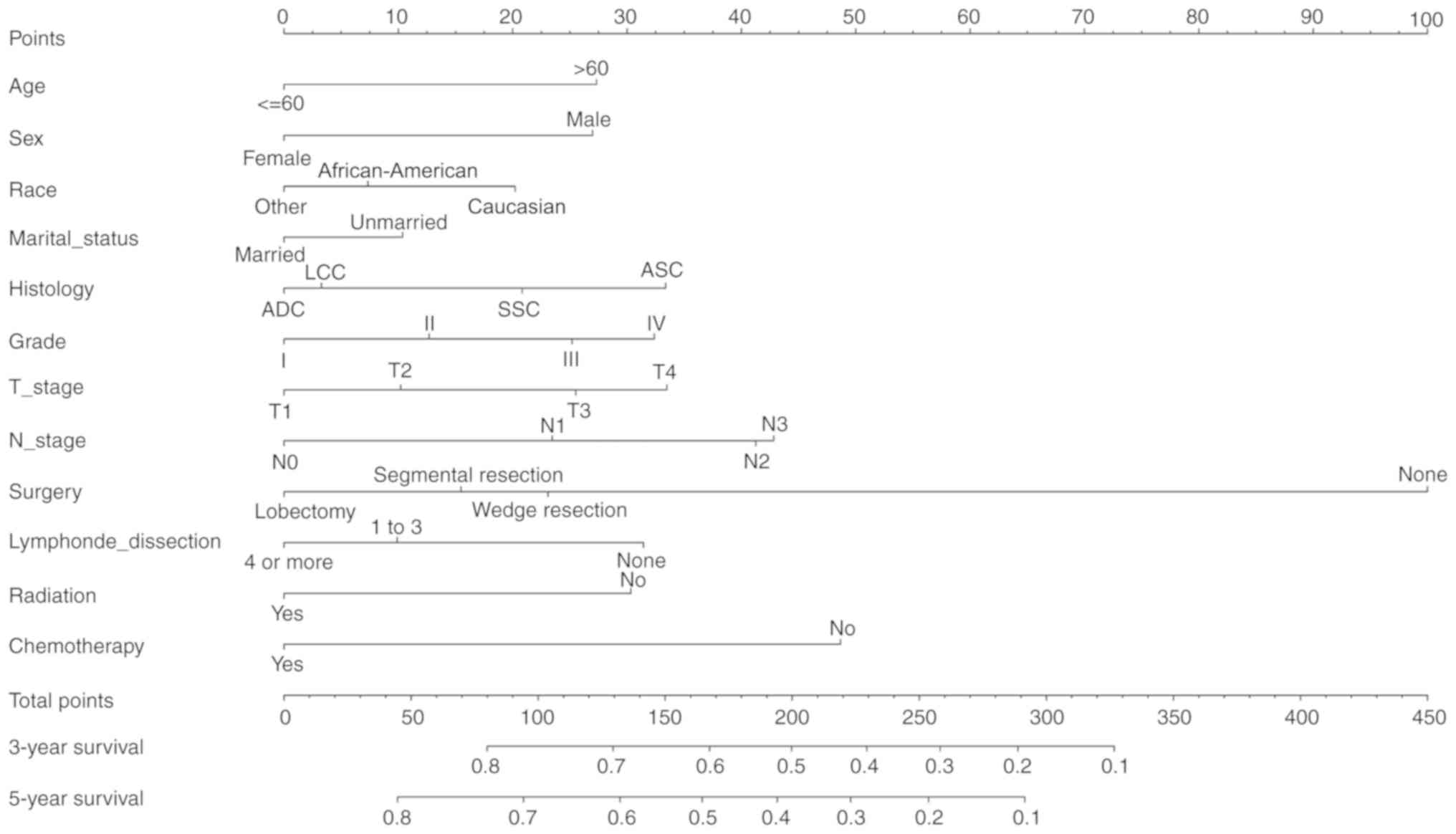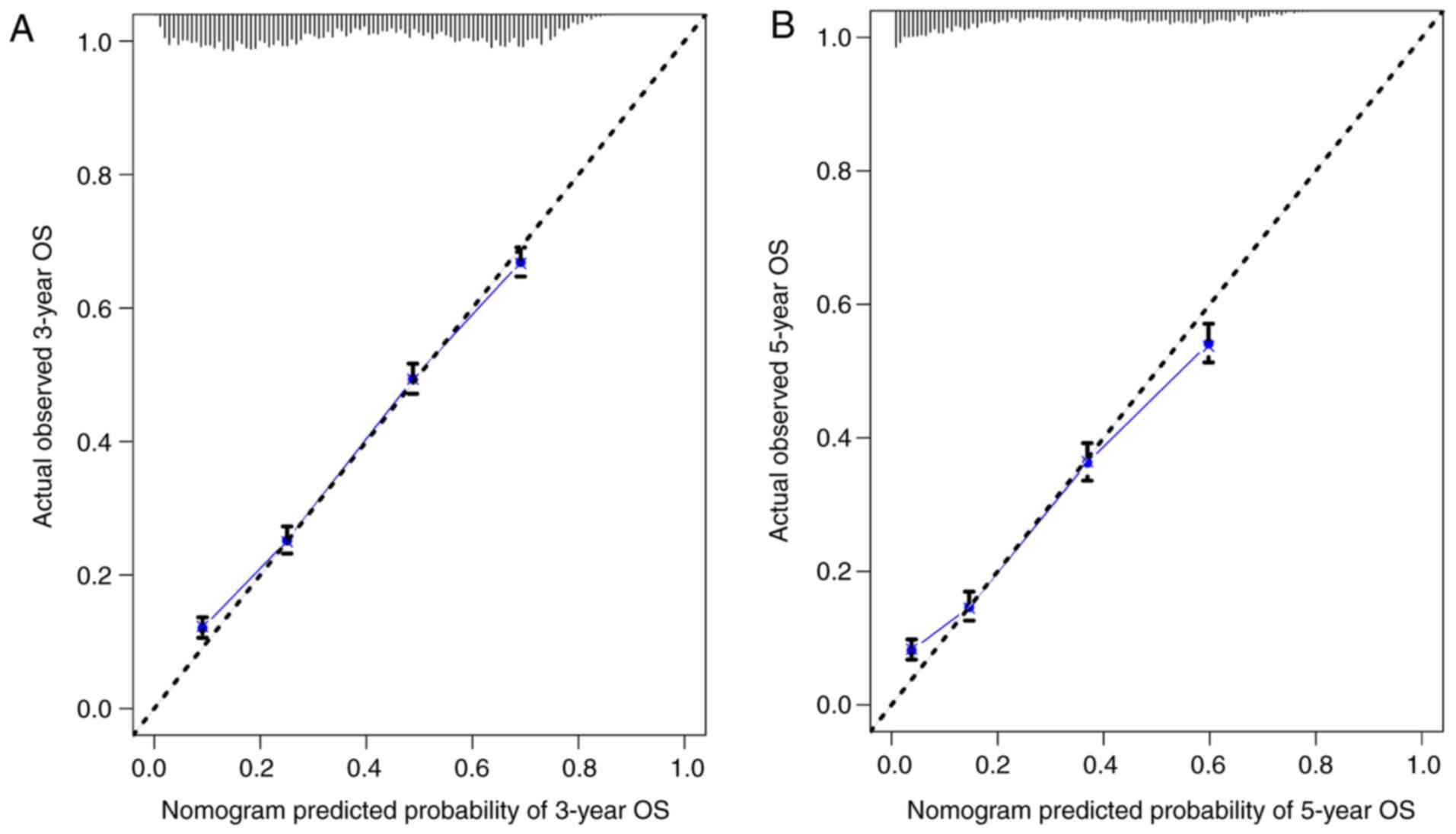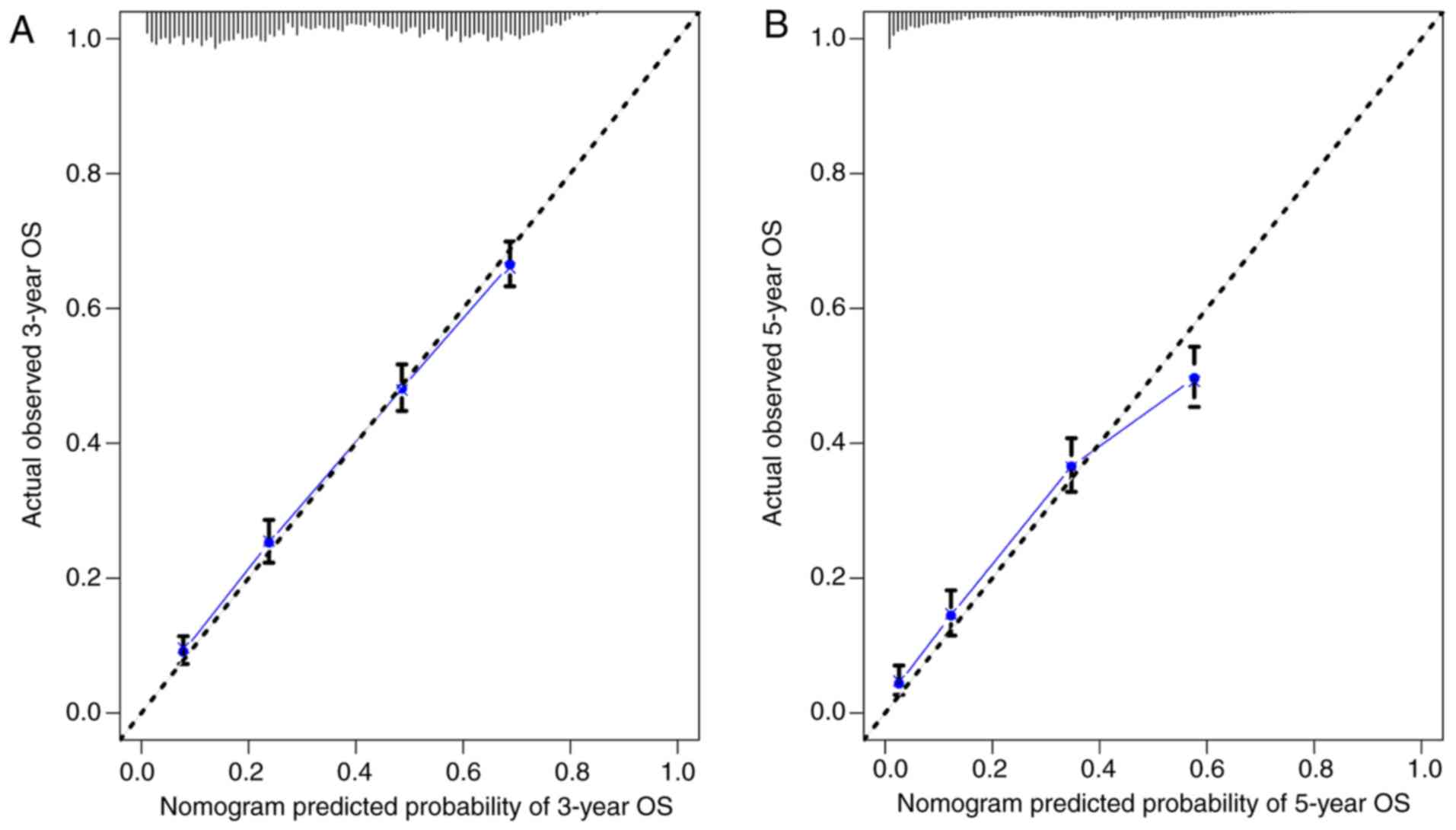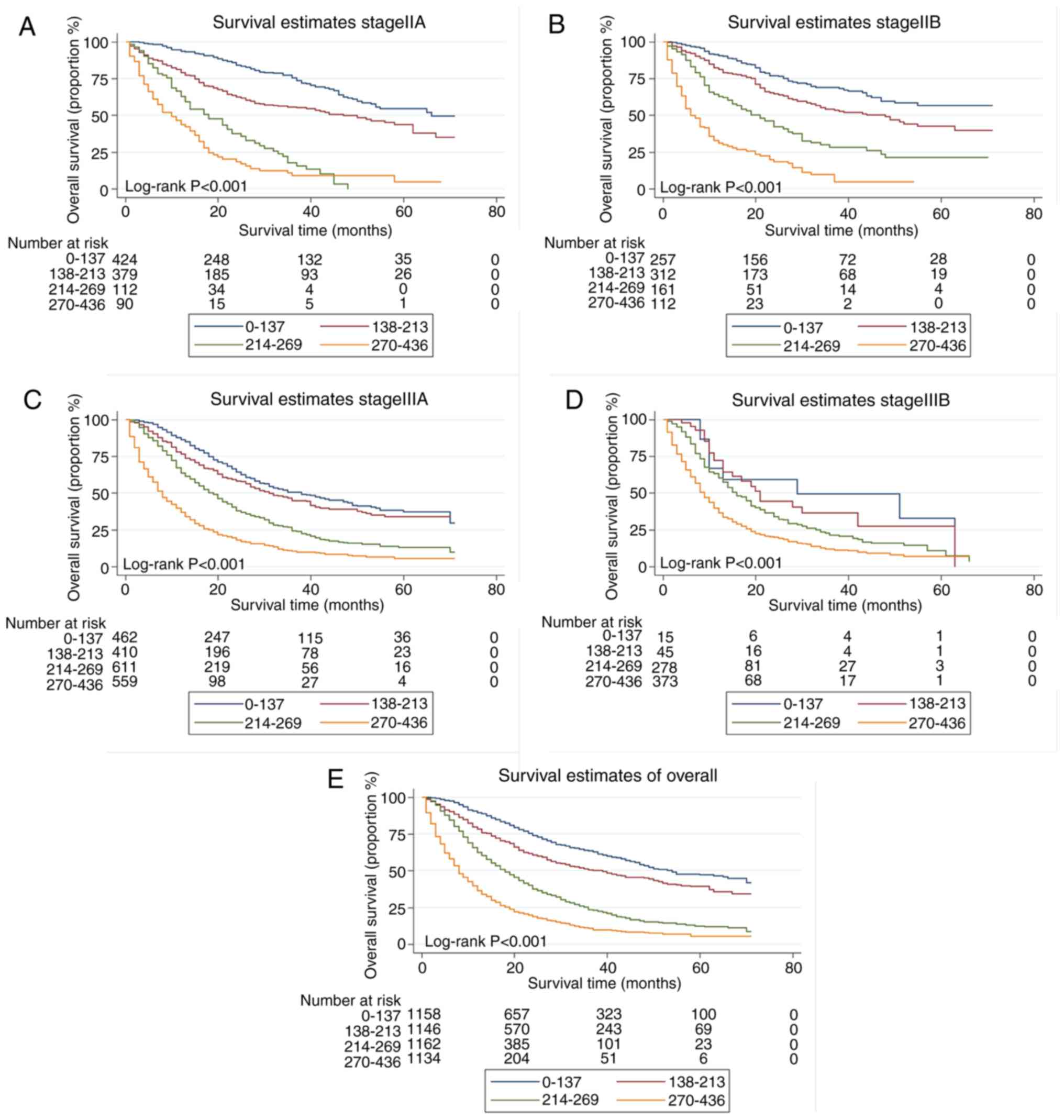|
1
|
Bray F, Ferlay J, Soerjomataram I, Siegel
RL, Torre LA and Jemal A: Global cancer statistics 2018: GLOBOCAN
estimates of incidence and mortality worldwide for 36 cancers in
185 countries. CA Cancer J Clin. 68:394–424. 2018. View Article : Google Scholar : PubMed/NCBI
|
|
2
|
Liu S, Chen Q, Guo L, Cao X, Sun X, Chen W
and He J: Incidence and mortality of lung cancer in China,
2008–2012. Chin J Cancer Res. 30:580–587. 2018. View Article : Google Scholar : PubMed/NCBI
|
|
3
|
Barlesi F, Mazieres J, Merlio JP,
Debieuvre D, Mosser J, Lena H, Ouafik L, Besse B, Rouquette I,
Westeel V, et al: Routine molecular profiling of patients with
advanced non-small-cell lung cancer: Results of a 1-year nationwide
programme of the French cooperative thoracic intergroup (IFCT).
Lancet. 387:1415–1426. 2016. View Article : Google Scholar : PubMed/NCBI
|
|
4
|
National Lung Screening Trial Research
Team, ; Church TR, Black WC, Aberle DR, Berg CD, Clingan KL, Duan
F, Fagerstrom RM, Gareen IF, Gierada DS, et al: Results of initial
low-dose computed tomographic screening for lung cancer. N Engl J
Med. 368:1980–1991. 2013. View Article : Google Scholar : PubMed/NCBI
|
|
5
|
Gorenstein LA and Sonett JR: The surgical
management of stage I and stage II lung cancer. Surg Oncol Clin N
Am. 20:701–720. 2011. View Article : Google Scholar : PubMed/NCBI
|
|
6
|
Filosso PL, Rena O, Donati G, Casadio C,
Ruffini E, Papalia E, Oliaro A and Maggi G: Bronchial carcinoid
tumors: Surgical management and long-term outcome. J Thorac
Cardiovasc Surg. 123:303–309. 2002. View Article : Google Scholar : PubMed/NCBI
|
|
7
|
Li Q, Xiao W, Xie T, He J, Han Y and Zhu
J: Surgical treatment for lung cancer in the elderly. Zhongguo Fei
Ai Za Zhi. 10:34–36. 2007.(In Chinese). PubMed/NCBI
|
|
8
|
König IR, Fuchs O, Hansen G, von Mutius E
and Kopp MV: What is precision medicine? Eur Respir J.
50:17003912017. View Article : Google Scholar : PubMed/NCBI
|
|
9
|
Rami-Porta R, Bolejack V, Crowley J, Ball
D, Kim J, Lyons G, Rice T, Suzuki K, Thomas CF Jr, Travis WD, et
al: The IASLC lung cancer staging project: Proposals for the
revisions of the T descriptors in the forthcoming eighth edition of
the TNM classification for lung cancer. J Thorac Oncol.
10:990–1003. 2015. View Article : Google Scholar : PubMed/NCBI
|
|
10
|
Balachandran VP, Gonen M, Smith JJ and
DeMatteo RP: Nomograms in oncology: More than meets the eye. Lancet
Oncol. 16:e173–e180. 2015. View Article : Google Scholar : PubMed/NCBI
|
|
11
|
Yang H, Li X, Shi J, Fu H, Yang H, Liang
Z, Xiong H and Wang H: A nomogram to predict prognosis in patients
undergoing sublobar resection for stage IA non-small-cell lung
cancer. Cancer Manag Res. 10:6611–6626. 2018. View Article : Google Scholar : PubMed/NCBI
|
|
12
|
Zhou H, Zhang Y, Qiu Z, Chen G, Hong S,
Chen X, Zhang Z, Huang Y and Zhang L: Nomogram to predict
cause-specific mortality in patients with surgically resected stage
I non-small-cell lung cancer: A competing risk analysis. Clin Lung
Cancer. 19:e195–e203. 2018. View Article : Google Scholar : PubMed/NCBI
|
|
13
|
Deng J, Ren Z, Wen J, Wang B, Hou X, Xue Z
and Chu X: Construction of a nomogram predicting the overall
survival of patients with distantly metastatic non-small-cell lung
cancer. Cancer Manag Res. 10:6143–6156. 2018. View Article : Google Scholar : PubMed/NCBI
|
|
14
|
Frank E and Harrel J; (homepage on the
Internet), : Rms: Regression Modeling Strategies. R Package Version
3.4–0. http://CRAN.Rproject.org/packagermsFebruary
19–2019
|
|
15
|
Heagerty PJ and Zheng Y: Survival model
predictive accuracy and ROC curves. Biometrics. 61:92–105. 2005.
View Article : Google Scholar : PubMed/NCBI
|
|
16
|
Socinski MA, Evans T, Gettinger S, Hensing
TA, VanDam Sequist L, Ireland B and Stinchcombe TE: Treatment of
stage IV non-small cell lung cancer: Diagnosis and management of
lung cancer, 3rd ed: American College of Chest Physicians
evidence-based clinical practice guidelines. Chest. 143 (5
Suppl):e341S–e368S. 2013. View Article : Google Scholar : PubMed/NCBI
|
|
17
|
Dziedzic DA, Rudzinski P, Langfort R and
Orlowski T; Polish Lung Cancer Study Group (PLCSG), : Risk factors
for local and distant recurrence after surgical treatment in
patients with non-small-cell lung cancer. Clin Lung Cancer.
17:e157–e167. 2016. View Article : Google Scholar : PubMed/NCBI
|
|
18
|
Wang BY, Huang JY, Cheng CY, Lin CH, Ko J
and Liaw YP: Lung cancer and prognosis in Taiwan: A
population-based cancer registry. J Thorac Oncol. 8:1128–1135.
2013. View Article : Google Scholar : PubMed/NCBI
|
|
19
|
Chang JW, Asamura H, Kawachi R and
Watanabe S: Gender difference in survival of resected non-small
cell lung cancer: Histology-related phenomenon? J Thorac Cardiovasc
Surg. 137:807–812. 2009. View Article : Google Scholar : PubMed/NCBI
|
|
20
|
Rosell R, Moran T, Queralt C, Porta R,
Cardenal F, Camps C, Majem M, Lopez-Vivanco G, Isla D and Provencio
M: Screening for epidermal growth factor receptor mutations in lung
cancer. N Engl J Med. 361:958–967. 2009. View Article : Google Scholar : PubMed/NCBI
|
|
21
|
Merrill RM and Johnson E: Benefits of
marriage on relative and conditional relative cancer survival
differ between males and females in the USA. J Cancer Surviv.
11:578–589. 2017. View Article : Google Scholar : PubMed/NCBI
|
|
22
|
Wu Y, Ai Z and Xu G: Marital status and
survival in patients with non-small cell lung cancer: An analysis
of 70006 patients in the SEER database. Oncotarget.
8:103518–103534. 2017.PubMed/NCBI
|
|
23
|
Varlotto JM, Voland R, McKie K, Flickinger
JC, DeCamp MM, Maddox D, Rava P, Fitzgerald TJ, Graeber G, Rassaei
N, et al: Population-based differences in the outcome and
presentation of lung cancer patients based upon racial, histologic,
and economic factors in all lung patients and those with metastatic
disease. Cancer Med. 7:1211–1220. 2018. View Article : Google Scholar : PubMed/NCBI
|
|
24
|
Richards TB, Henley SJ, Puckett MC, Weir
HK, Huang B, Tucker TC and Allemani C: Lung cancer survival in the
United States by race and stage (2001–2009): Findings from the
CONCORD-2 study. Cancer. 123 (Suppl 24):S5079–S5099. 2017.
View Article : Google Scholar
|
|
25
|
Williams CD, Salama JK, Moghanaki D, Karas
TZ and Kelley MJ: Impact of race on treatment and survival among
U.S. veterans with early-stage lung cancer. J Thorac Oncol.
11:1672–1681. 2016. View Article : Google Scholar : PubMed/NCBI
|
|
26
|
Tannenbaum SL, Koru-Sengul T, Zhao W, Miao
F and Byrne MM: Survival disparities in non-small cell lung cancer
by race, ethnicity, and socioeconomic status. Cancer J. 20:237–245.
2014. View Article : Google Scholar : PubMed/NCBI
|
|
27
|
Asamura H, Goya T, Koshiishi Y, Sohara Y,
Eguchi K, Mori M, Nakanishi Y, Tsuchiya R, Shimokata K, Inoue H, et
al: A Japanese lung cancer registry study: Prognosis of 13,010
resected lung cancers. J Thorac Oncol. 3:46–52. 2008. View Article : Google Scholar : PubMed/NCBI
|
|
28
|
Cho BC, DE Pas T, Kalofonos H, Wang Q,
Ramlau R, Cheng Y, Vitiello F, Laisaar T, Vallières E, Kubisa B, et
al: Prognostic factors in early-stage NSCLC: Analysis of the
placebo group in the MAGRIT study. Anticancer Res. 39:1403–1409.
2019. View Article : Google Scholar : PubMed/NCBI
|
|
29
|
Li H, Sun Z, Yang F, Sui X, Liu T and Wang
J: Primary tumour resection in non-small-cell lung cancer patients
with ipsilateral pleural dissemination (M1a): A population-based
study. Eur J Cardiothorac Surg. 55:1121–1129. 2019. View Article : Google Scholar : PubMed/NCBI
|
|
30
|
Meng F, Zhang L, Ren Y and Ma Q: The
genomic alterations of lung adenocarcinoma and lung squamous cell
carcinoma can explain the differences of their overall survival
rates. J Cell Physiol. 234:10918–10925. 2019. View Article : Google Scholar : PubMed/NCBI
|
|
31
|
Rice TW, Gress DM, Patil DT, Hofstetter
WL, Kelsen DP and Blackstone EH: Cancer of the esophagus and
esophagogastric junction-major changes in the American joint
committee on cancer eighth edition cancer staging manual. CA Cancer
J Clin. 67:304–317. 2017. View Article : Google Scholar : PubMed/NCBI
|
|
32
|
Speicher PJ, Gu L, Gulack BC, Wang X,
D'Amico TA, Hartwig MG and Berry MF: Sublobar resection for
clinical stage IA non-small-cell lung cancer in the United States.
Clin Lung Cancer. 17:47–55. 2016. View Article : Google Scholar : PubMed/NCBI
|
|
33
|
Zhang Y, Sun Y, Wang R, Ye T, Zhang Y and
Chen H: Meta-analysis of lobectomy, segmentectomy, and wedge
resection for stage I non-small cell lung cancer. J Surg Oncol.
111:334–340. 2015. View Article : Google Scholar : PubMed/NCBI
|
|
34
|
NCCN Guidelines Insights (homepage on the
Internet), . Non-Small Cell Lung Cancer, Version 3. 2019,
https://.nccn.org/patientsFebruary
19–2019
|
|
35
|
Rami-Porta R, Asamura H, Travis WD and
Rusch VW: Lung cancer-major changes in the American joint committee
on cancer eighth edition cancer staging manual. CA Cancer J Clin.
67:138–155. 2017. View Article : Google Scholar : PubMed/NCBI
|
|
36
|
Hughes MJ, Chowdhry MF, Woolley SM and
Walker WS: In patients undergoing lung resection for non-small cell
lung cancer, is lymph node dissection or sampling superior?
Interact Cardiovasc Thorac Surg. 13:311–315. 2011. View Article : Google Scholar : PubMed/NCBI
|
|
37
|
Sugi K, Nawata K, Fujita N, Ueda K, Tanaka
T, Matsuoka T, Kaneda Y and Esato K: Systematic lymph node
dissection for clinically diagnosed peripheral non-small-cell lung
cancer less than 2 cm in diameter. World J Surg. 22:290–295. 1998.
View Article : Google Scholar : PubMed/NCBI
|
|
38
|
Lardinois D, De Leyn P, Van Schil P, Porta
RR, Waller D, Passlick B, Zielinski M, Lerut T and Weder W: ESTS
guidelines for intraoperative lymph node staging in non-small cell
lung cancer. Eur J Cardiothorac Surg. 30:787–792. 2006. View Article : Google Scholar : PubMed/NCBI
|
|
39
|
Adachi H, Sakamaki K, Nishii T, Yamamoto
T, Nagashima T, Ishikawa Y, Ando K, Yamanaka K, Watanabe K,
Kumakiri Y, et al: Lobe-specific lymph node dissection as a
standard procedure in surgery for non-small cell lung cancer: A
propensity score matching study. J Thorac Oncol. 12:85–93. 2017.
View Article : Google Scholar : PubMed/NCBI
|
|
40
|
Nagasaka M and Gadgeel SM: Role of
chemotherapy and targeted therapy in early-stage non-small cell
lung cancer. Expert Rev Anticancer Ther. 18:63–70. 2018. View Article : Google Scholar : PubMed/NCBI
|
|
41
|
Salazar MC, Rosen JE, Wang Z, Arnold BN,
Thomas DC, Herbst RS, Kim AW, Detterbeck FC, Blasberg JD and Boffa
DJ: Association of delayed adjuvant chemotherapy with survival
after lung cancer surgery. JAMA Oncol. 3:610–619. 2017. View Article : Google Scholar : PubMed/NCBI
|
|
42
|
Chen D, Wang H, Song X, Yue J and Yu J:
Preoperative radiation may improve the outcomes of resectable
IIIA/N2 non-small-cell lung cancer patients: A propensity score
matching-based analysis from surveillance, epidemiology, and end
results database. Cancer Med. 7:4354–4360. 2018. View Article : Google Scholar : PubMed/NCBI
|
|
43
|
Benveniste MF, Gomez D, Carter BW,
Betancourt Cuellar SL, Shroff GS, Benveniste APA, Odisio EG and
Marom EM: Recognizing radiation therapy-related complications in
the chest. Radiographics. 39:344–366. 2019. View Article : Google Scholar : PubMed/NCBI
|
|
44
|
Bradley J and Hu C: Learning from trials
on radiation dose in non-small cell lung cancer. Int J Radiat Oncol
Biol Phys. 96:748–750. 2016. View Article : Google Scholar : PubMed/NCBI
|
|
45
|
Edge SB, Byrd DR, Compton CC, Fritz AG,
Greene FL and Trotti A: AJCC Cancer Staging Manual7th edition.
Springer; New York, NY: 2009
|


















